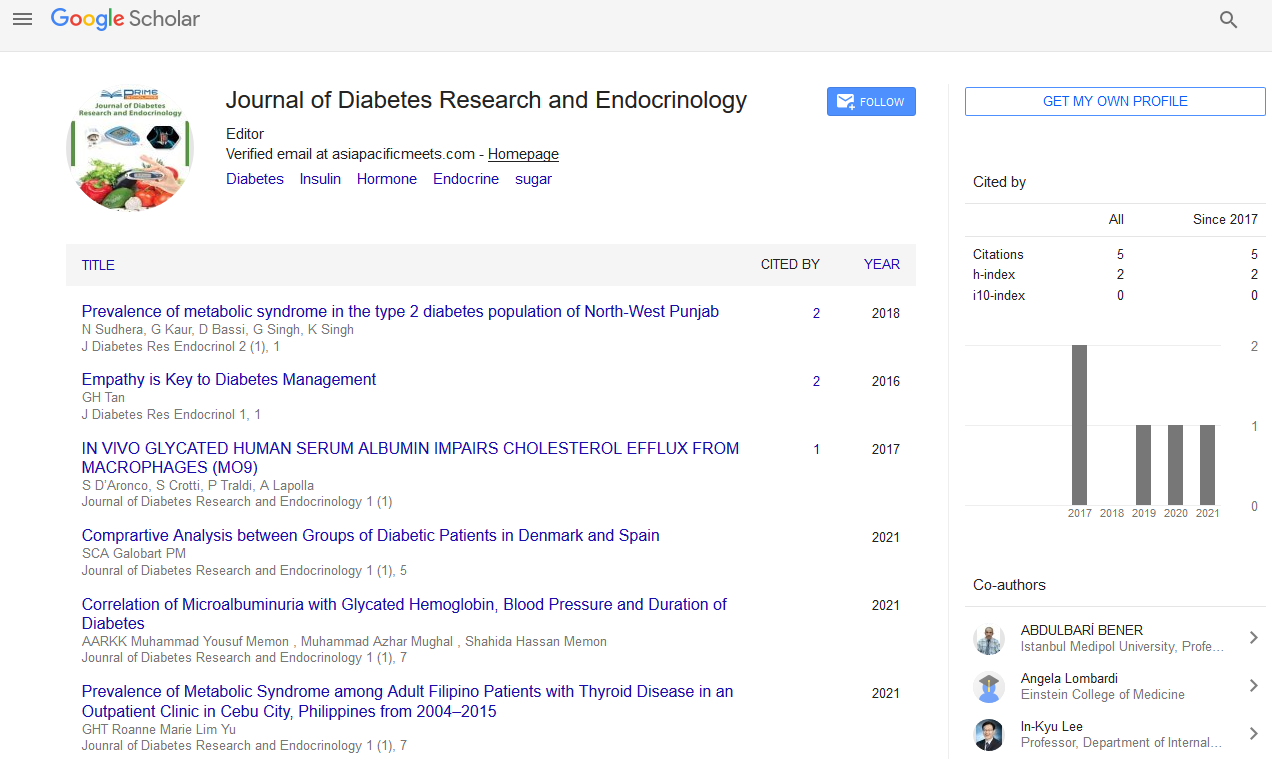Commentary - (2022) Volume 6, Issue 6
Skeletal Muscle is the Largest and Most Energy-Consuming Organ in the Human Body
Karolina Morze*
Department of Endocrinology, Catholic University, Angola
*Correspondence:
Karolina Morze,
Department of Endocrinology, Catholic University,
Angola,
Email:
Received: 01-Nov-2022, Manuscript No. IPJDRE-22-15030;
Editor assigned: 03-Nov-2022, Pre QC No. IPJDRE-22-15030 (PQ);
Reviewed: 17-Nov-2022, QC No. IPJDRE-22-15030;
Revised: 22-Nov-2022, Manuscript No. IPJDRE-22-15030 (R);
Published:
29-Nov-2022, DOI: 10.36648/IPJDRE.6.6.31
Description
Skeletal muscle plays an important role in energy metabolism
and glucose uptake. Skeletal muscle glucose uptake is markedly
reduced in patients with type 2 diabetes (DM). Aerobic exercise
can reduce hyperglycemia and improve insulin resistance in
people with type 2 diabetes. Insulin exerts a variety of effects,
many of which include increasing glucose uptake, promoting
glycogen synthesis and inhibiting glycogenolysis, increasing
free fatty acid uptake, increasing protein synthesis, promoting
muscle hypertrophy, and reducing protein breakdown. Such
inhibition is mediated by Akt. Skeletal muscle mass gradually
decreases with age, leading to a decline in muscle strength and
physical function. Sarcopenia is a syndrome characterized by
decreased skeletal muscle mass, muscle weakness, and loss of
physical function. Decreased organ function leads to susceptibility
to external stress. Frailty is associated with falls, fractures,
and hospitalization. However, it is reversible to return to
a healthy state with appropriate intervention. Frailty next he is
divided into three subgroups.
Euglycemic diabetic ketoacidosis (DKA) is an acute, life-threatening
metabolic disorder characterized by ketoacidosis and relatively
low blood glucose levels (<11 mmol/L). The absence of
hyperglycemia is a mystery to emergency room and intensive
care physicians. Diagnosis and treatment may be delayed, leading
to worse outcomes. Euglycemic DKA is a rare diagnosis but
can occur in patients with type 1 or type 2 diabetes. Addition
of sodium/glucose cotransporter-2 inhibitors for the treatment
of diabetes mellitus increased the incidence of euglycemic
DKA. Other causes of euglycemic DKA are pregnancy, fasting,
bariatric surgery, gastroparesis, insulin pump failure, cocaine
addiction, chronic liver disease, and glycogen storage disease.
The pathophysiology of euglycemic DKA includes relative or
absolute carbohydrate deficiency, a reduced degree of insulin
deficiency or resistance, and an elevated glucagon/insulin ratio.
Euglycemic DKA is a diagnosis of exclusion and should be
considered in the differential diagnosis of patients with a history of diabetes mellitus despite hypoglycemia or urinary ketone
deficiency. Diagnostic evaluation includes exclusion of arterial
blood gases, serum ketones, and other causes of high anion
gap metabolic acidosis in metabolic acidosis.
Pterostilbene, a phenolic compound derived from resveratrol,
has better bioavailability than the parent compound due to the
presence of two methoxyl groups. This review summarizes the
beneficial effects of pterostilbene on diabetes, fatty liver and
dyslipidemia. Pterostilbene is a bioactive compound useful for
the prevention of type 1 diabetes, insulin resistance and type
2 diabetes in animal models, with respect to type 1 diabetes,
the main mechanisms described to justify the beneficial effects
of this phenolic compound are an increase in hepatic glycogen
content, hepatic glucokinase and phosphofructokinase activity,
restoration of pancreatic islet structure. Similar to type 2 diabetes,
increased hepatic glucokinase and glucose-6-phosphatase
activities and decreased fructose-1, 6-biphosphatase activity
have been reported. Dietary induction of insulin resistance results
in greater activation of the insulin signaling cascade, increasing
levels of cardiotrophin-1 and hepatic glucokinase and
glucose-6-phosphatase activity, fructose-1, it has been reported
to reduce 6-biphosphatase activity. Although there are few
data on pterostilbene and hepatic steatosis to date, reduction
of oxidative stress by pterostilbene may be involved, as oxidative
stress is associated with progression from steatosis to steatohepatitis.
Finally, pterostilbene effectively lowers total cholesterol,
LDL cholesterol, and serum triglyceride levels while
increasing HDL cholesterol in animal models of dyslipidemia.
Acknowledgement
None.
Conflict of Interest
The authors declare that they have no conflict of interest.
Citation: Morze K (2022) Skeletal Muscle is the Largest and Most Energy-Consuming Organ in the Human Body. J Diab Res Endocrinol.
6:31.
Copyright: © 2022 Morze K. This is an open-access article distributed under the terms of the Creative Commons Attribution
License, which permits unrestricted use, distribution, and reproduction in any medium, provided the original author and source
are credited.

